Analyzing Cultural Differences in Healthcare Teams & Management
VerifiedAdded on 2023/06/13
|14
|4396
|218
Report
AI Summary
This report provides an overview of culture, teamwork, and motivation within the healthcare sector, emphasizing the significant role culture plays in organizations. It addresses how companies manage and mitigate cultural issues through training and development to enhance productivity. The report defines culture, identifies cultural differences in healthcare settings, and explores cultural barriers, offering strategies to overcome them for effective teamwork. It also discusses the advantages and disadvantages of cultural diversity in the workplace, examines cultural differences within teams, and highlights the importance of diversity training in hospitals. Furthermore, it emphasizes learning from colleagues from different cultures, effective workplace diversity management, and the benefits of cultural differences, while also addressing unique challenges faced by healthcare teams. The report concludes by underscoring the importance of cultural understanding and effective management in fostering a productive and inclusive healthcare environment. Desklib provides access to this and many other solved assignments.
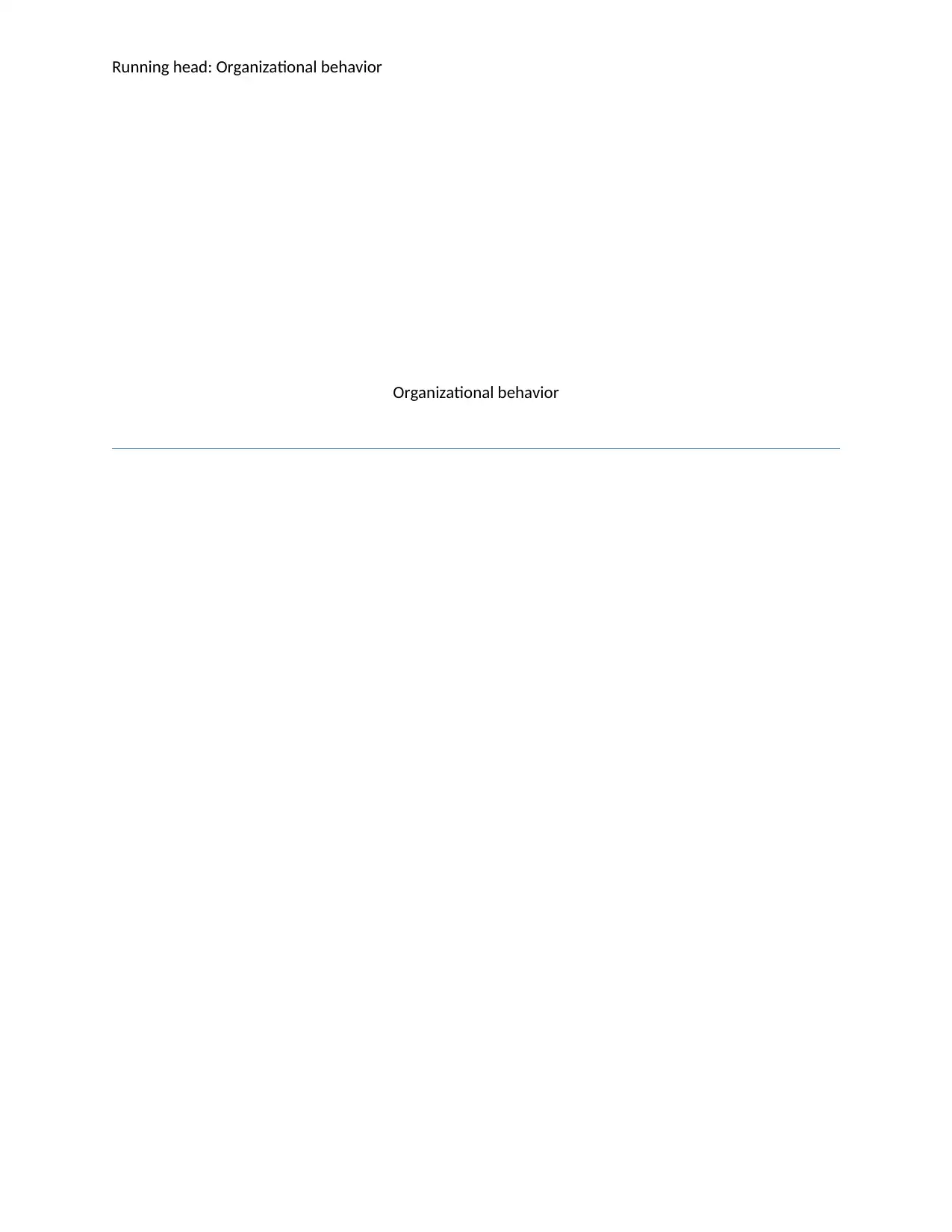
Running head: Organizational behavior
Organizational behavior
Organizational behavior
Paraphrase This Document
Need a fresh take? Get an instant paraphrase of this document with our AI Paraphraser
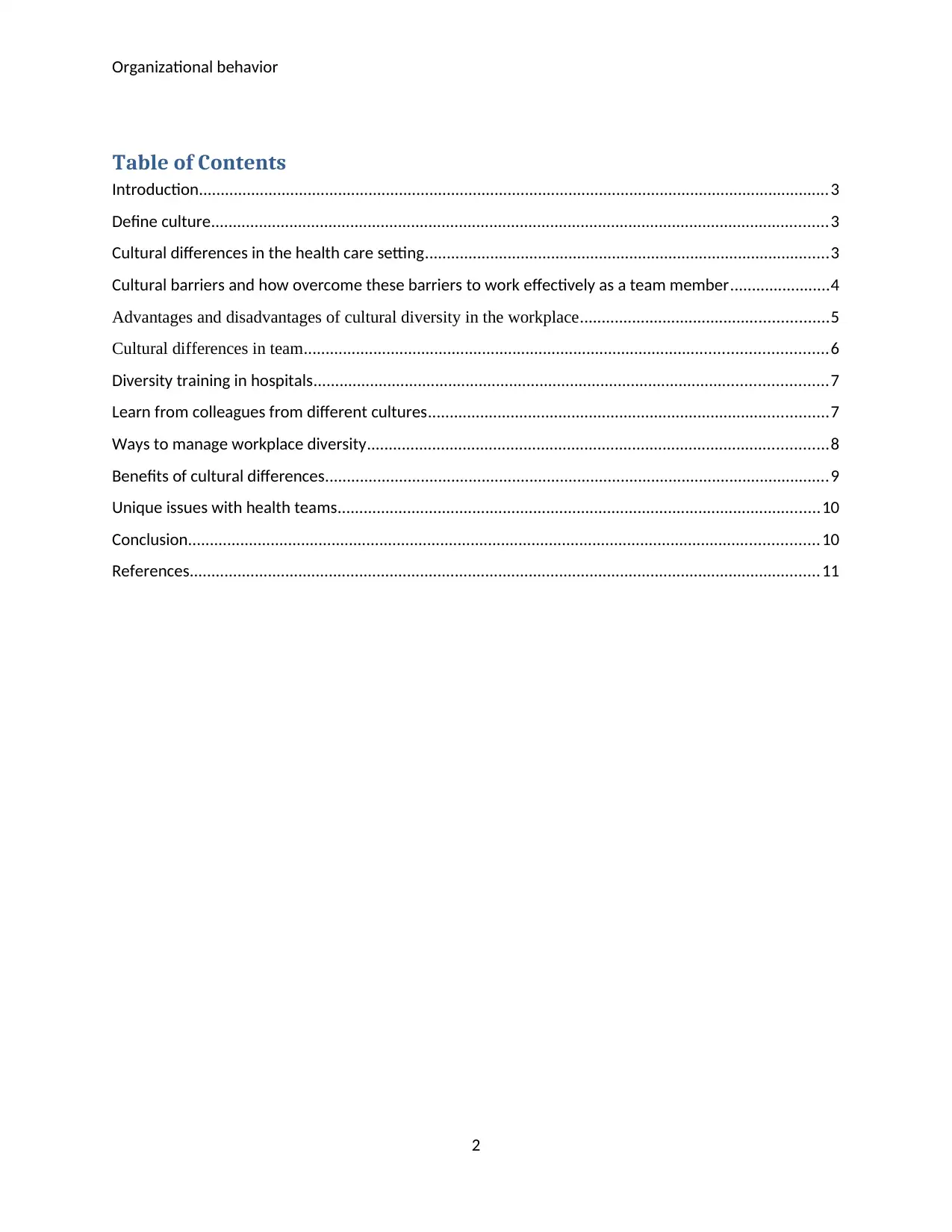
Organizational behavior
Table of Contents
Introduction.................................................................................................................................................3
Define culture..............................................................................................................................................3
Cultural differences in the health care setting.............................................................................................3
Cultural barriers and how overcome these barriers to work effectively as a team member.......................4
Advantages and disadvantages of cultural diversity in the workplace.........................................................5
Cultural differences in team........................................................................................................................6
Diversity training in hospitals......................................................................................................................7
Learn from colleagues from different cultures............................................................................................7
Ways to manage workplace diversity..........................................................................................................8
Benefits of cultural differences....................................................................................................................9
Unique issues with health teams...............................................................................................................10
Conclusion.................................................................................................................................................10
References.................................................................................................................................................11
2
Table of Contents
Introduction.................................................................................................................................................3
Define culture..............................................................................................................................................3
Cultural differences in the health care setting.............................................................................................3
Cultural barriers and how overcome these barriers to work effectively as a team member.......................4
Advantages and disadvantages of cultural diversity in the workplace.........................................................5
Cultural differences in team........................................................................................................................6
Diversity training in hospitals......................................................................................................................7
Learn from colleagues from different cultures............................................................................................7
Ways to manage workplace diversity..........................................................................................................8
Benefits of cultural differences....................................................................................................................9
Unique issues with health teams...............................................................................................................10
Conclusion.................................................................................................................................................10
References.................................................................................................................................................11
2
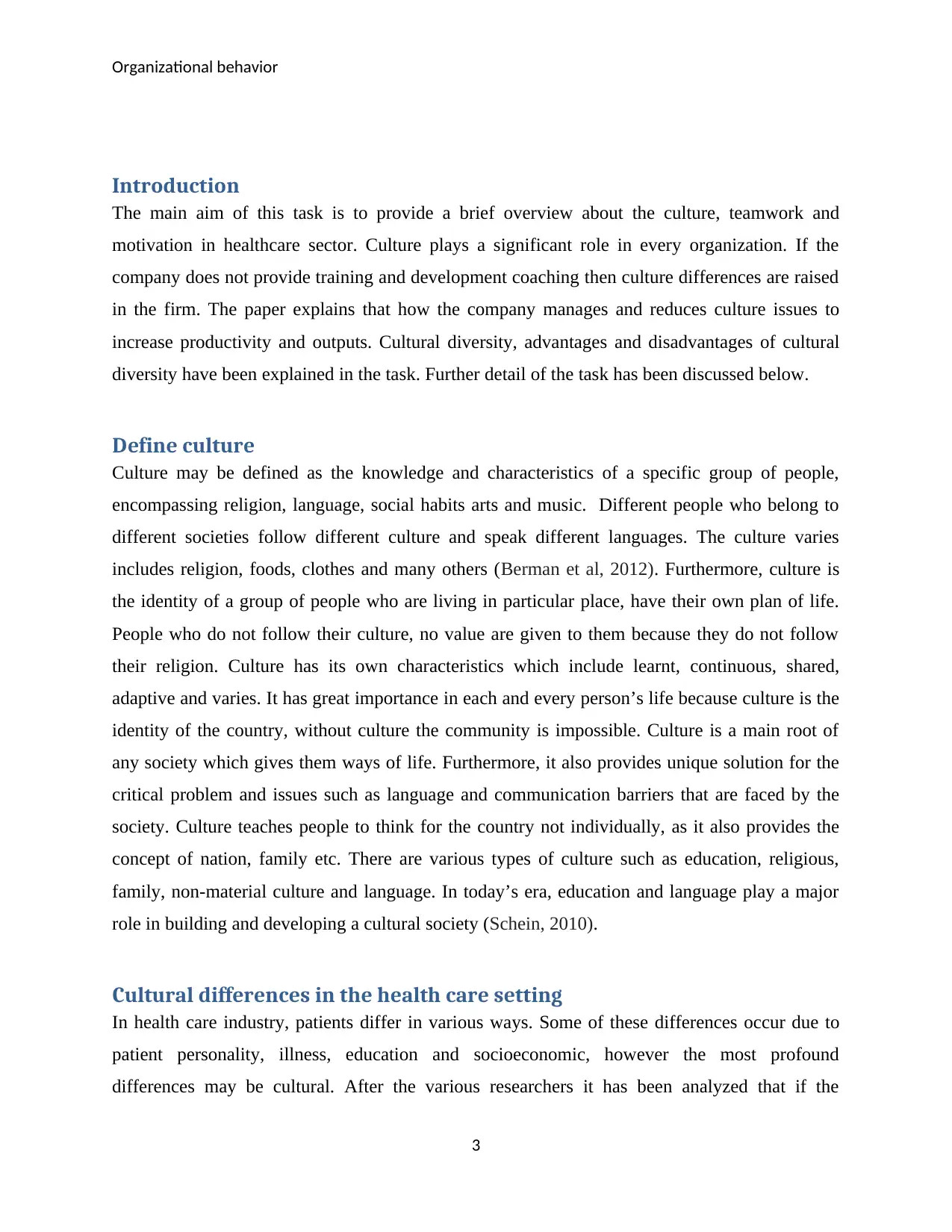
Organizational behavior
Introduction
The main aim of this task is to provide a brief overview about the culture, teamwork and
motivation in healthcare sector. Culture plays a significant role in every organization. If the
company does not provide training and development coaching then culture differences are raised
in the firm. The paper explains that how the company manages and reduces culture issues to
increase productivity and outputs. Cultural diversity, advantages and disadvantages of cultural
diversity have been explained in the task. Further detail of the task has been discussed below.
Define culture
Culture may be defined as the knowledge and characteristics of a specific group of people,
encompassing religion, language, social habits arts and music. Different people who belong to
different societies follow different culture and speak different languages. The culture varies
includes religion, foods, clothes and many others (Berman et al, 2012). Furthermore, culture is
the identity of a group of people who are living in particular place, have their own plan of life.
People who do not follow their culture, no value are given to them because they do not follow
their religion. Culture has its own characteristics which include learnt, continuous, shared,
adaptive and varies. It has great importance in each and every person’s life because culture is the
identity of the country, without culture the community is impossible. Culture is a main root of
any society which gives them ways of life. Furthermore, it also provides unique solution for the
critical problem and issues such as language and communication barriers that are faced by the
society. Culture teaches people to think for the country not individually, as it also provides the
concept of nation, family etc. There are various types of culture such as education, religious,
family, non-material culture and language. In today’s era, education and language play a major
role in building and developing a cultural society (Schein, 2010).
Cultural differences in the health care setting
In health care industry, patients differ in various ways. Some of these differences occur due to
patient personality, illness, education and socioeconomic, however the most profound
differences may be cultural. After the various researchers it has been analyzed that if the
3
Introduction
The main aim of this task is to provide a brief overview about the culture, teamwork and
motivation in healthcare sector. Culture plays a significant role in every organization. If the
company does not provide training and development coaching then culture differences are raised
in the firm. The paper explains that how the company manages and reduces culture issues to
increase productivity and outputs. Cultural diversity, advantages and disadvantages of cultural
diversity have been explained in the task. Further detail of the task has been discussed below.
Define culture
Culture may be defined as the knowledge and characteristics of a specific group of people,
encompassing religion, language, social habits arts and music. Different people who belong to
different societies follow different culture and speak different languages. The culture varies
includes religion, foods, clothes and many others (Berman et al, 2012). Furthermore, culture is
the identity of a group of people who are living in particular place, have their own plan of life.
People who do not follow their culture, no value are given to them because they do not follow
their religion. Culture has its own characteristics which include learnt, continuous, shared,
adaptive and varies. It has great importance in each and every person’s life because culture is the
identity of the country, without culture the community is impossible. Culture is a main root of
any society which gives them ways of life. Furthermore, it also provides unique solution for the
critical problem and issues such as language and communication barriers that are faced by the
society. Culture teaches people to think for the country not individually, as it also provides the
concept of nation, family etc. There are various types of culture such as education, religious,
family, non-material culture and language. In today’s era, education and language play a major
role in building and developing a cultural society (Schein, 2010).
Cultural differences in the health care setting
In health care industry, patients differ in various ways. Some of these differences occur due to
patient personality, illness, education and socioeconomic, however the most profound
differences may be cultural. After the various researchers it has been analyzed that if the
3
⊘ This is a preview!⊘
Do you want full access?
Subscribe today to unlock all pages.

Trusted by 1+ million students worldwide
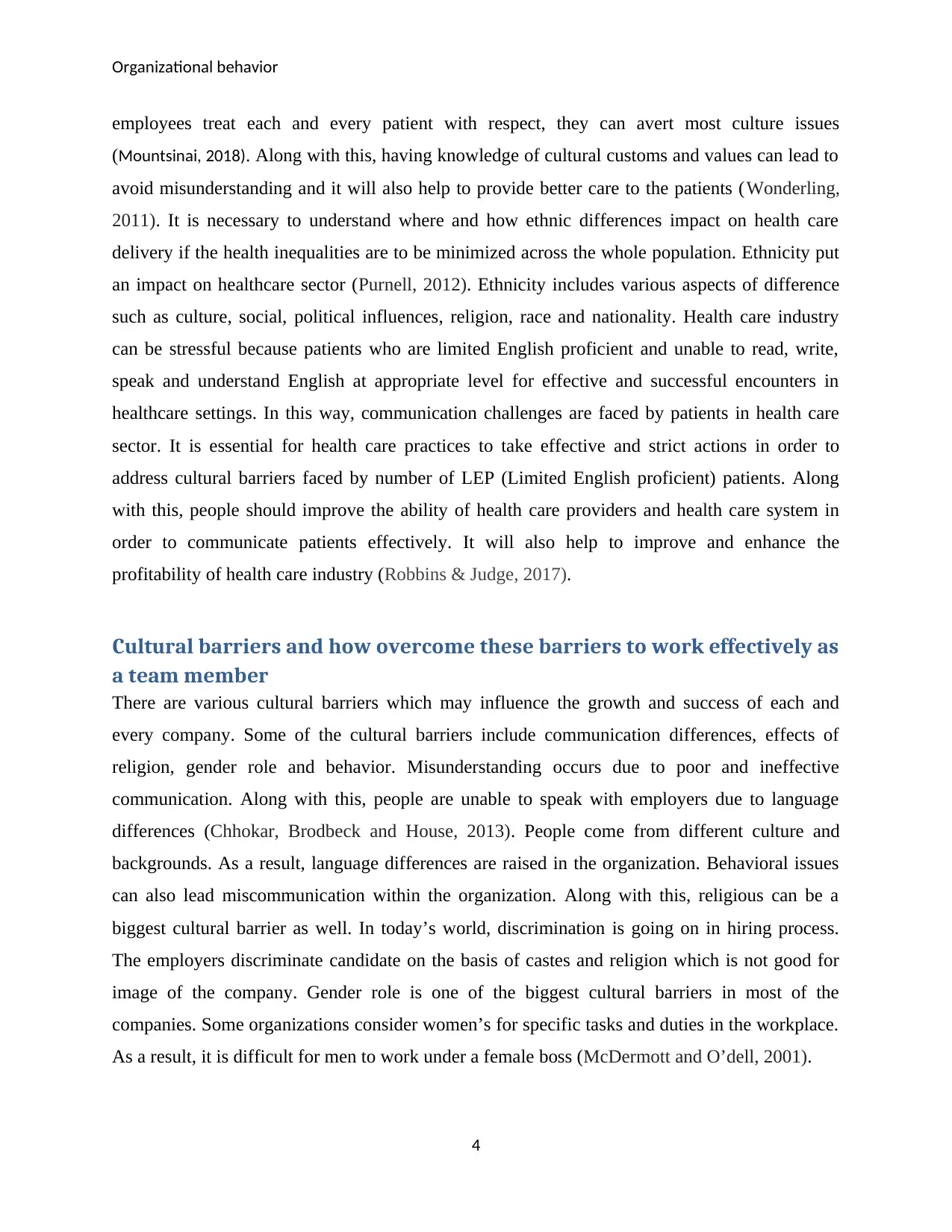
Organizational behavior
employees treat each and every patient with respect, they can avert most culture issues
(Mountsinai, 2018). Along with this, having knowledge of cultural customs and values can lead to
avoid misunderstanding and it will also help to provide better care to the patients (Wonderling,
2011). It is necessary to understand where and how ethnic differences impact on health care
delivery if the health inequalities are to be minimized across the whole population. Ethnicity put
an impact on healthcare sector (Purnell, 2012). Ethnicity includes various aspects of difference
such as culture, social, political influences, religion, race and nationality. Health care industry
can be stressful because patients who are limited English proficient and unable to read, write,
speak and understand English at appropriate level for effective and successful encounters in
healthcare settings. In this way, communication challenges are faced by patients in health care
sector. It is essential for health care practices to take effective and strict actions in order to
address cultural barriers faced by number of LEP (Limited English proficient) patients. Along
with this, people should improve the ability of health care providers and health care system in
order to communicate patients effectively. It will also help to improve and enhance the
profitability of health care industry (Robbins & Judge, 2017).
Cultural barriers and how overcome these barriers to work effectively as
a team member
There are various cultural barriers which may influence the growth and success of each and
every company. Some of the cultural barriers include communication differences, effects of
religion, gender role and behavior. Misunderstanding occurs due to poor and ineffective
communication. Along with this, people are unable to speak with employers due to language
differences (Chhokar, Brodbeck and House, 2013). People come from different culture and
backgrounds. As a result, language differences are raised in the organization. Behavioral issues
can also lead miscommunication within the organization. Along with this, religious can be a
biggest cultural barrier as well. In today’s world, discrimination is going on in hiring process.
The employers discriminate candidate on the basis of castes and religion which is not good for
image of the company. Gender role is one of the biggest cultural barriers in most of the
companies. Some organizations consider women’s for specific tasks and duties in the workplace.
As a result, it is difficult for men to work under a female boss (McDermott and O’dell, 2001).
4
employees treat each and every patient with respect, they can avert most culture issues
(Mountsinai, 2018). Along with this, having knowledge of cultural customs and values can lead to
avoid misunderstanding and it will also help to provide better care to the patients (Wonderling,
2011). It is necessary to understand where and how ethnic differences impact on health care
delivery if the health inequalities are to be minimized across the whole population. Ethnicity put
an impact on healthcare sector (Purnell, 2012). Ethnicity includes various aspects of difference
such as culture, social, political influences, religion, race and nationality. Health care industry
can be stressful because patients who are limited English proficient and unable to read, write,
speak and understand English at appropriate level for effective and successful encounters in
healthcare settings. In this way, communication challenges are faced by patients in health care
sector. It is essential for health care practices to take effective and strict actions in order to
address cultural barriers faced by number of LEP (Limited English proficient) patients. Along
with this, people should improve the ability of health care providers and health care system in
order to communicate patients effectively. It will also help to improve and enhance the
profitability of health care industry (Robbins & Judge, 2017).
Cultural barriers and how overcome these barriers to work effectively as
a team member
There are various cultural barriers which may influence the growth and success of each and
every company. Some of the cultural barriers include communication differences, effects of
religion, gender role and behavior. Misunderstanding occurs due to poor and ineffective
communication. Along with this, people are unable to speak with employers due to language
differences (Chhokar, Brodbeck and House, 2013). People come from different culture and
backgrounds. As a result, language differences are raised in the organization. Behavioral issues
can also lead miscommunication within the organization. Along with this, religious can be a
biggest cultural barrier as well. In today’s world, discrimination is going on in hiring process.
The employers discriminate candidate on the basis of castes and religion which is not good for
image of the company. Gender role is one of the biggest cultural barriers in most of the
companies. Some organizations consider women’s for specific tasks and duties in the workplace.
As a result, it is difficult for men to work under a female boss (McDermott and O’dell, 2001).
4
Paraphrase This Document
Need a fresh take? Get an instant paraphrase of this document with our AI Paraphraser
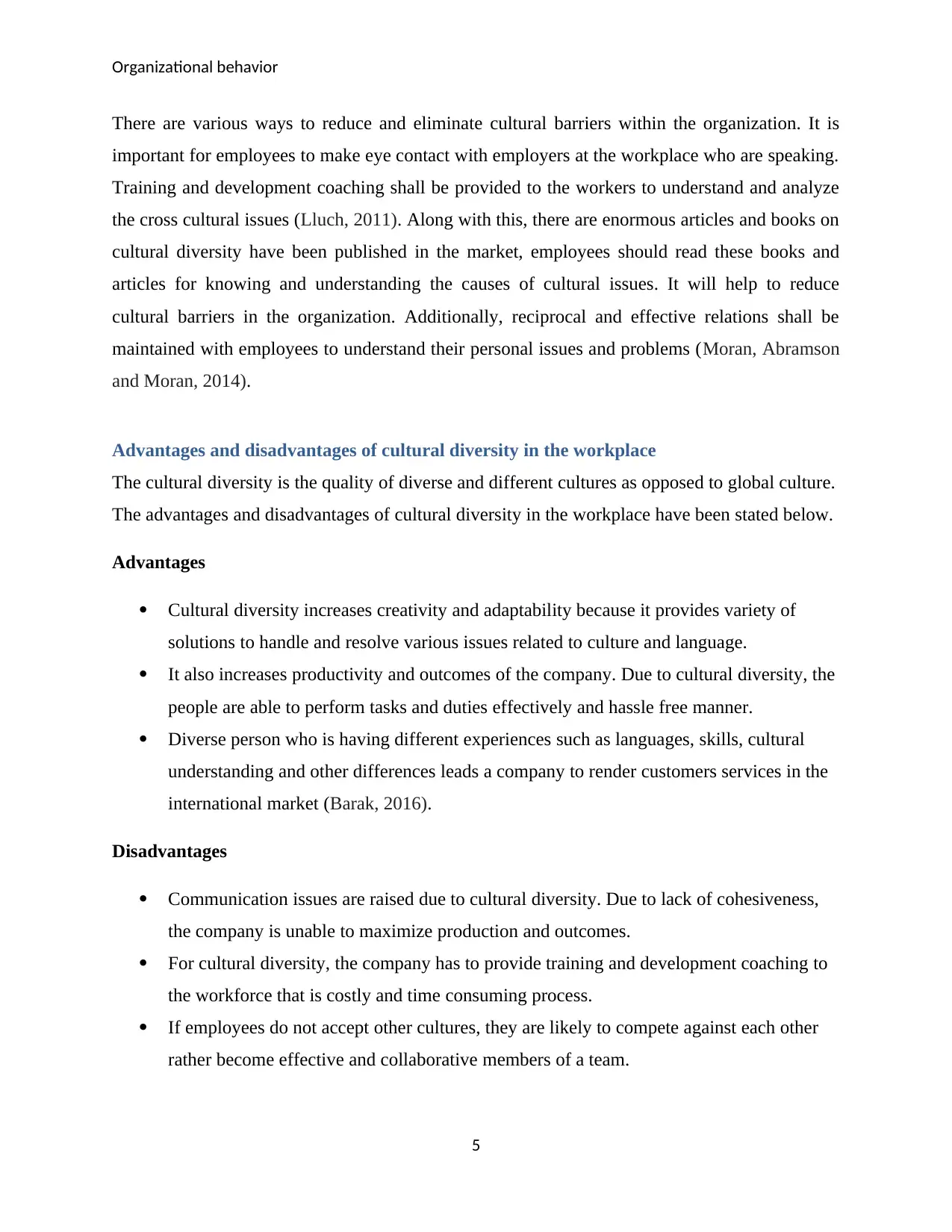
Organizational behavior
There are various ways to reduce and eliminate cultural barriers within the organization. It is
important for employees to make eye contact with employers at the workplace who are speaking.
Training and development coaching shall be provided to the workers to understand and analyze
the cross cultural issues (Lluch, 2011). Along with this, there are enormous articles and books on
cultural diversity have been published in the market, employees should read these books and
articles for knowing and understanding the causes of cultural issues. It will help to reduce
cultural barriers in the organization. Additionally, reciprocal and effective relations shall be
maintained with employees to understand their personal issues and problems (Moran, Abramson
and Moran, 2014).
Advantages and disadvantages of cultural diversity in the workplace
The cultural diversity is the quality of diverse and different cultures as opposed to global culture.
The advantages and disadvantages of cultural diversity in the workplace have been stated below.
Advantages
Cultural diversity increases creativity and adaptability because it provides variety of
solutions to handle and resolve various issues related to culture and language.
It also increases productivity and outcomes of the company. Due to cultural diversity, the
people are able to perform tasks and duties effectively and hassle free manner.
Diverse person who is having different experiences such as languages, skills, cultural
understanding and other differences leads a company to render customers services in the
international market (Barak, 2016).
Disadvantages
Communication issues are raised due to cultural diversity. Due to lack of cohesiveness,
the company is unable to maximize production and outcomes.
For cultural diversity, the company has to provide training and development coaching to
the workforce that is costly and time consuming process.
If employees do not accept other cultures, they are likely to compete against each other
rather become effective and collaborative members of a team.
5
There are various ways to reduce and eliminate cultural barriers within the organization. It is
important for employees to make eye contact with employers at the workplace who are speaking.
Training and development coaching shall be provided to the workers to understand and analyze
the cross cultural issues (Lluch, 2011). Along with this, there are enormous articles and books on
cultural diversity have been published in the market, employees should read these books and
articles for knowing and understanding the causes of cultural issues. It will help to reduce
cultural barriers in the organization. Additionally, reciprocal and effective relations shall be
maintained with employees to understand their personal issues and problems (Moran, Abramson
and Moran, 2014).
Advantages and disadvantages of cultural diversity in the workplace
The cultural diversity is the quality of diverse and different cultures as opposed to global culture.
The advantages and disadvantages of cultural diversity in the workplace have been stated below.
Advantages
Cultural diversity increases creativity and adaptability because it provides variety of
solutions to handle and resolve various issues related to culture and language.
It also increases productivity and outcomes of the company. Due to cultural diversity, the
people are able to perform tasks and duties effectively and hassle free manner.
Diverse person who is having different experiences such as languages, skills, cultural
understanding and other differences leads a company to render customers services in the
international market (Barak, 2016).
Disadvantages
Communication issues are raised due to cultural diversity. Due to lack of cohesiveness,
the company is unable to maximize production and outcomes.
For cultural diversity, the company has to provide training and development coaching to
the workforce that is costly and time consuming process.
If employees do not accept other cultures, they are likely to compete against each other
rather become effective and collaborative members of a team.
5
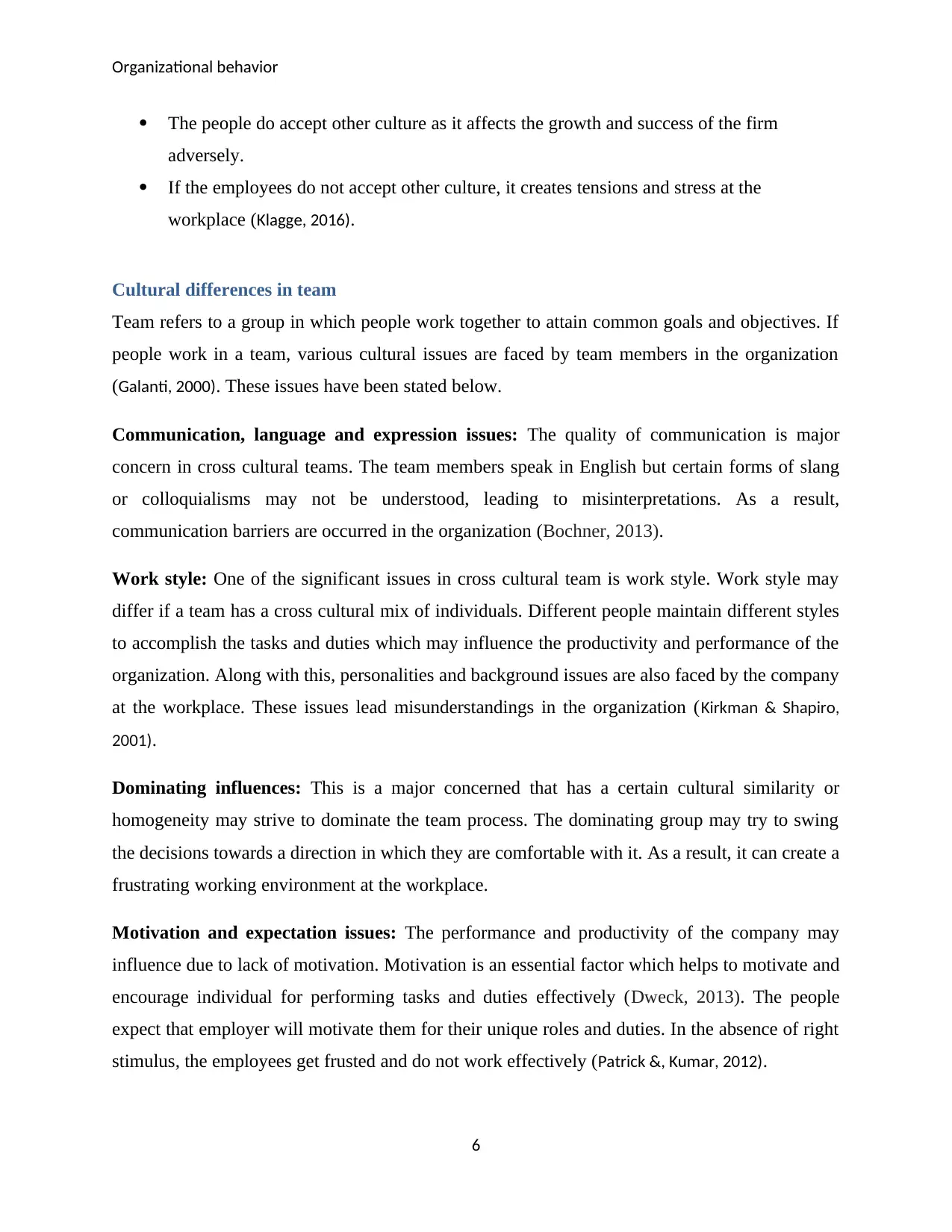
Organizational behavior
The people do accept other culture as it affects the growth and success of the firm
adversely.
If the employees do not accept other culture, it creates tensions and stress at the
workplace (Klagge, 2016).
Cultural differences in team
Team refers to a group in which people work together to attain common goals and objectives. If
people work in a team, various cultural issues are faced by team members in the organization
(Galanti, 2000). These issues have been stated below.
Communication, language and expression issues: The quality of communication is major
concern in cross cultural teams. The team members speak in English but certain forms of slang
or colloquialisms may not be understood, leading to misinterpretations. As a result,
communication barriers are occurred in the organization (Bochner, 2013).
Work style: One of the significant issues in cross cultural team is work style. Work style may
differ if a team has a cross cultural mix of individuals. Different people maintain different styles
to accomplish the tasks and duties which may influence the productivity and performance of the
organization. Along with this, personalities and background issues are also faced by the company
at the workplace. These issues lead misunderstandings in the organization (Kirkman & Shapiro,
2001).
Dominating influences: This is a major concerned that has a certain cultural similarity or
homogeneity may strive to dominate the team process. The dominating group may try to swing
the decisions towards a direction in which they are comfortable with it. As a result, it can create a
frustrating working environment at the workplace.
Motivation and expectation issues: The performance and productivity of the company may
influence due to lack of motivation. Motivation is an essential factor which helps to motivate and
encourage individual for performing tasks and duties effectively (Dweck, 2013). The people
expect that employer will motivate them for their unique roles and duties. In the absence of right
stimulus, the employees get frusted and do not work effectively (Patrick &, Kumar, 2012).
6
The people do accept other culture as it affects the growth and success of the firm
adversely.
If the employees do not accept other culture, it creates tensions and stress at the
workplace (Klagge, 2016).
Cultural differences in team
Team refers to a group in which people work together to attain common goals and objectives. If
people work in a team, various cultural issues are faced by team members in the organization
(Galanti, 2000). These issues have been stated below.
Communication, language and expression issues: The quality of communication is major
concern in cross cultural teams. The team members speak in English but certain forms of slang
or colloquialisms may not be understood, leading to misinterpretations. As a result,
communication barriers are occurred in the organization (Bochner, 2013).
Work style: One of the significant issues in cross cultural team is work style. Work style may
differ if a team has a cross cultural mix of individuals. Different people maintain different styles
to accomplish the tasks and duties which may influence the productivity and performance of the
organization. Along with this, personalities and background issues are also faced by the company
at the workplace. These issues lead misunderstandings in the organization (Kirkman & Shapiro,
2001).
Dominating influences: This is a major concerned that has a certain cultural similarity or
homogeneity may strive to dominate the team process. The dominating group may try to swing
the decisions towards a direction in which they are comfortable with it. As a result, it can create a
frustrating working environment at the workplace.
Motivation and expectation issues: The performance and productivity of the company may
influence due to lack of motivation. Motivation is an essential factor which helps to motivate and
encourage individual for performing tasks and duties effectively (Dweck, 2013). The people
expect that employer will motivate them for their unique roles and duties. In the absence of right
stimulus, the employees get frusted and do not work effectively (Patrick &, Kumar, 2012).
6
⊘ This is a preview!⊘
Do you want full access?
Subscribe today to unlock all pages.

Trusted by 1+ million students worldwide
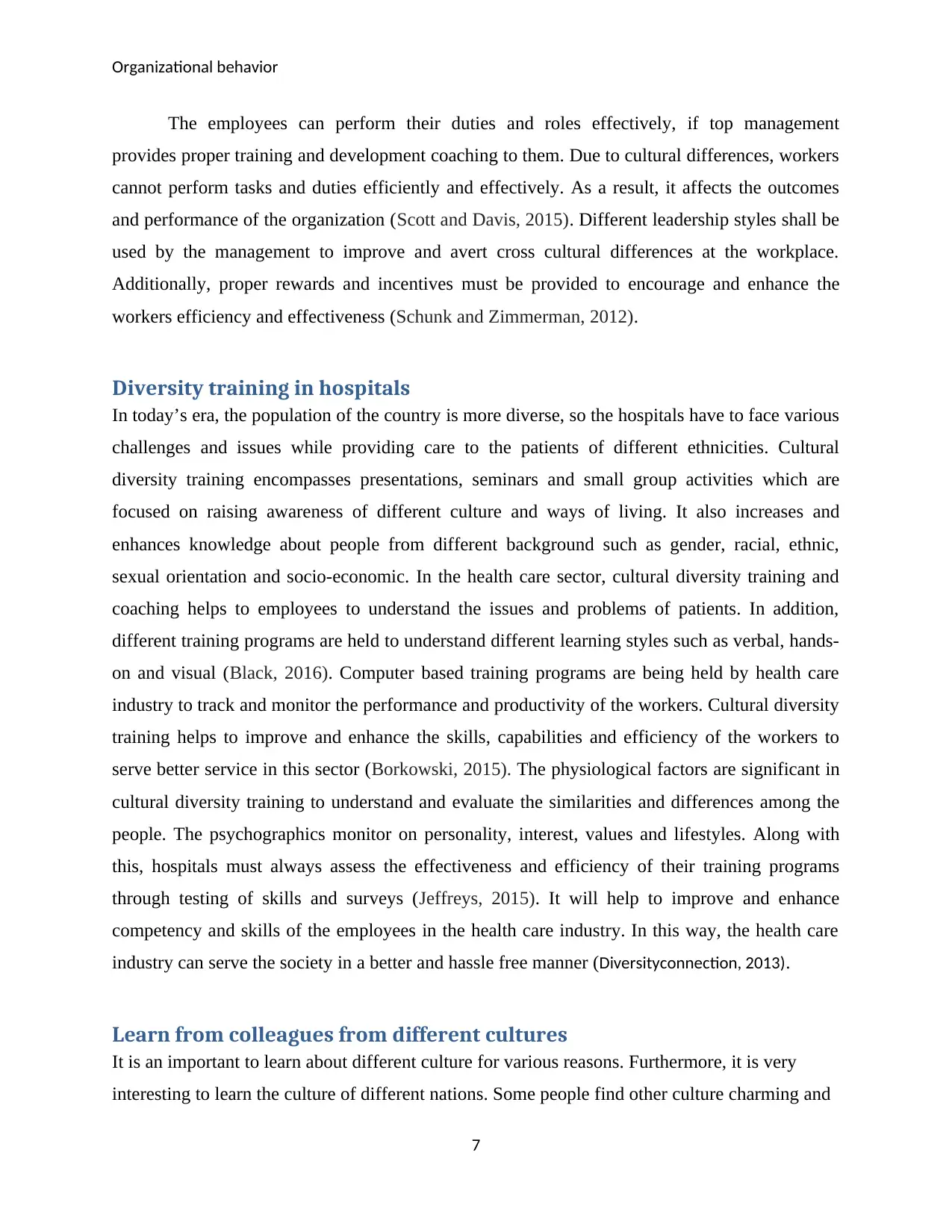
Organizational behavior
The employees can perform their duties and roles effectively, if top management
provides proper training and development coaching to them. Due to cultural differences, workers
cannot perform tasks and duties efficiently and effectively. As a result, it affects the outcomes
and performance of the organization (Scott and Davis, 2015). Different leadership styles shall be
used by the management to improve and avert cross cultural differences at the workplace.
Additionally, proper rewards and incentives must be provided to encourage and enhance the
workers efficiency and effectiveness (Schunk and Zimmerman, 2012).
Diversity training in hospitals
In today’s era, the population of the country is more diverse, so the hospitals have to face various
challenges and issues while providing care to the patients of different ethnicities. Cultural
diversity training encompasses presentations, seminars and small group activities which are
focused on raising awareness of different culture and ways of living. It also increases and
enhances knowledge about people from different background such as gender, racial, ethnic,
sexual orientation and socio-economic. In the health care sector, cultural diversity training and
coaching helps to employees to understand the issues and problems of patients. In addition,
different training programs are held to understand different learning styles such as verbal, hands-
on and visual (Black, 2016). Computer based training programs are being held by health care
industry to track and monitor the performance and productivity of the workers. Cultural diversity
training helps to improve and enhance the skills, capabilities and efficiency of the workers to
serve better service in this sector (Borkowski, 2015). The physiological factors are significant in
cultural diversity training to understand and evaluate the similarities and differences among the
people. The psychographics monitor on personality, interest, values and lifestyles. Along with
this, hospitals must always assess the effectiveness and efficiency of their training programs
through testing of skills and surveys (Jeffreys, 2015). It will help to improve and enhance
competency and skills of the employees in the health care industry. In this way, the health care
industry can serve the society in a better and hassle free manner (Diversityconnection, 2013).
Learn from colleagues from different cultures
It is an important to learn about different culture for various reasons. Furthermore, it is very
interesting to learn the culture of different nations. Some people find other culture charming and
7
The employees can perform their duties and roles effectively, if top management
provides proper training and development coaching to them. Due to cultural differences, workers
cannot perform tasks and duties efficiently and effectively. As a result, it affects the outcomes
and performance of the organization (Scott and Davis, 2015). Different leadership styles shall be
used by the management to improve and avert cross cultural differences at the workplace.
Additionally, proper rewards and incentives must be provided to encourage and enhance the
workers efficiency and effectiveness (Schunk and Zimmerman, 2012).
Diversity training in hospitals
In today’s era, the population of the country is more diverse, so the hospitals have to face various
challenges and issues while providing care to the patients of different ethnicities. Cultural
diversity training encompasses presentations, seminars and small group activities which are
focused on raising awareness of different culture and ways of living. It also increases and
enhances knowledge about people from different background such as gender, racial, ethnic,
sexual orientation and socio-economic. In the health care sector, cultural diversity training and
coaching helps to employees to understand the issues and problems of patients. In addition,
different training programs are held to understand different learning styles such as verbal, hands-
on and visual (Black, 2016). Computer based training programs are being held by health care
industry to track and monitor the performance and productivity of the workers. Cultural diversity
training helps to improve and enhance the skills, capabilities and efficiency of the workers to
serve better service in this sector (Borkowski, 2015). The physiological factors are significant in
cultural diversity training to understand and evaluate the similarities and differences among the
people. The psychographics monitor on personality, interest, values and lifestyles. Along with
this, hospitals must always assess the effectiveness and efficiency of their training programs
through testing of skills and surveys (Jeffreys, 2015). It will help to improve and enhance
competency and skills of the employees in the health care industry. In this way, the health care
industry can serve the society in a better and hassle free manner (Diversityconnection, 2013).
Learn from colleagues from different cultures
It is an important to learn about different culture for various reasons. Furthermore, it is very
interesting to learn the culture of different nations. Some people find other culture charming and
7
Paraphrase This Document
Need a fresh take? Get an instant paraphrase of this document with our AI Paraphraser
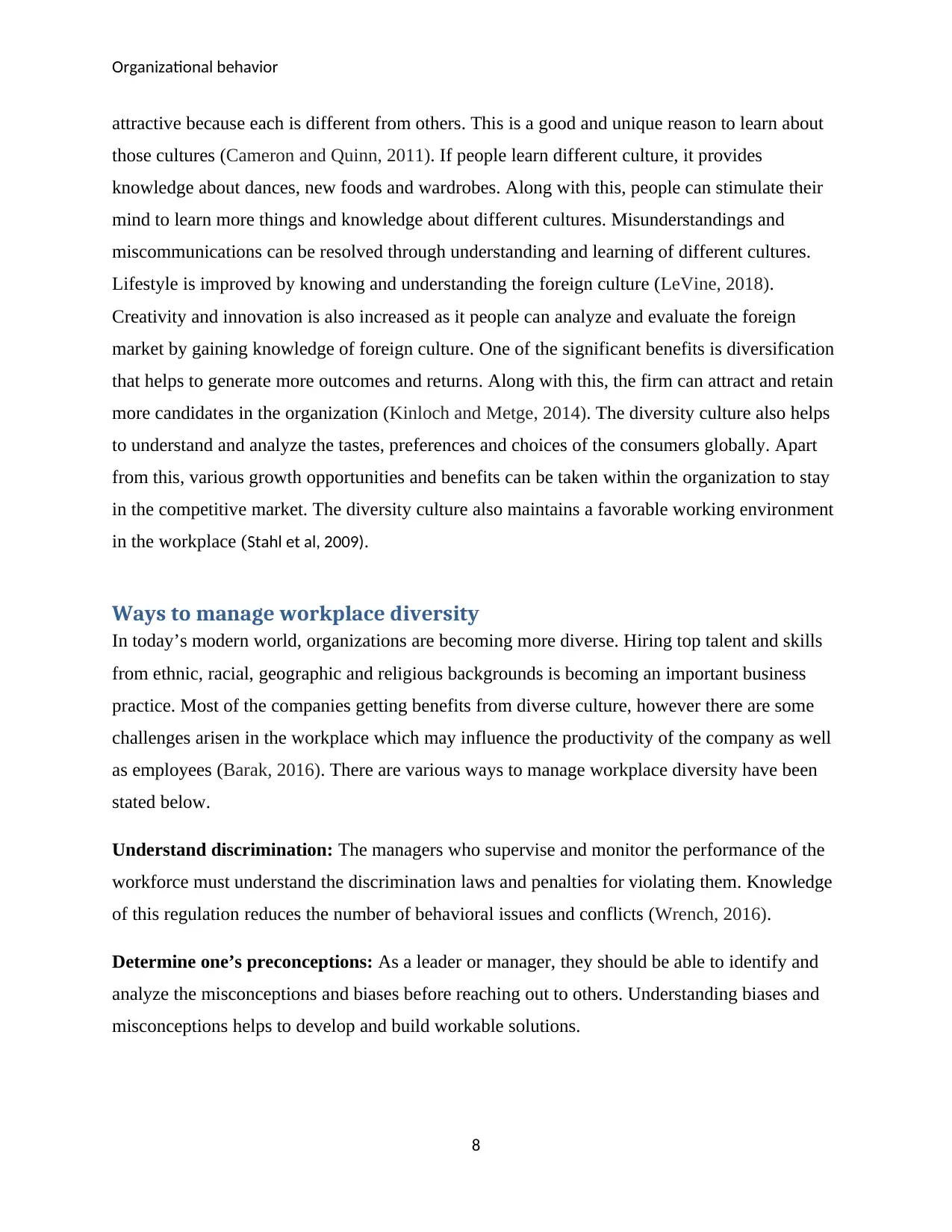
Organizational behavior
attractive because each is different from others. This is a good and unique reason to learn about
those cultures (Cameron and Quinn, 2011). If people learn different culture, it provides
knowledge about dances, new foods and wardrobes. Along with this, people can stimulate their
mind to learn more things and knowledge about different cultures. Misunderstandings and
miscommunications can be resolved through understanding and learning of different cultures.
Lifestyle is improved by knowing and understanding the foreign culture (LeVine, 2018).
Creativity and innovation is also increased as it people can analyze and evaluate the foreign
market by gaining knowledge of foreign culture. One of the significant benefits is diversification
that helps to generate more outcomes and returns. Along with this, the firm can attract and retain
more candidates in the organization (Kinloch and Metge, 2014). The diversity culture also helps
to understand and analyze the tastes, preferences and choices of the consumers globally. Apart
from this, various growth opportunities and benefits can be taken within the organization to stay
in the competitive market. The diversity culture also maintains a favorable working environment
in the workplace (Stahl et al, 2009).
Ways to manage workplace diversity
In today’s modern world, organizations are becoming more diverse. Hiring top talent and skills
from ethnic, racial, geographic and religious backgrounds is becoming an important business
practice. Most of the companies getting benefits from diverse culture, however there are some
challenges arisen in the workplace which may influence the productivity of the company as well
as employees (Barak, 2016). There are various ways to manage workplace diversity have been
stated below.
Understand discrimination: The managers who supervise and monitor the performance of the
workforce must understand the discrimination laws and penalties for violating them. Knowledge
of this regulation reduces the number of behavioral issues and conflicts (Wrench, 2016).
Determine one’s preconceptions: As a leader or manager, they should be able to identify and
analyze the misconceptions and biases before reaching out to others. Understanding biases and
misconceptions helps to develop and build workable solutions.
8
attractive because each is different from others. This is a good and unique reason to learn about
those cultures (Cameron and Quinn, 2011). If people learn different culture, it provides
knowledge about dances, new foods and wardrobes. Along with this, people can stimulate their
mind to learn more things and knowledge about different cultures. Misunderstandings and
miscommunications can be resolved through understanding and learning of different cultures.
Lifestyle is improved by knowing and understanding the foreign culture (LeVine, 2018).
Creativity and innovation is also increased as it people can analyze and evaluate the foreign
market by gaining knowledge of foreign culture. One of the significant benefits is diversification
that helps to generate more outcomes and returns. Along with this, the firm can attract and retain
more candidates in the organization (Kinloch and Metge, 2014). The diversity culture also helps
to understand and analyze the tastes, preferences and choices of the consumers globally. Apart
from this, various growth opportunities and benefits can be taken within the organization to stay
in the competitive market. The diversity culture also maintains a favorable working environment
in the workplace (Stahl et al, 2009).
Ways to manage workplace diversity
In today’s modern world, organizations are becoming more diverse. Hiring top talent and skills
from ethnic, racial, geographic and religious backgrounds is becoming an important business
practice. Most of the companies getting benefits from diverse culture, however there are some
challenges arisen in the workplace which may influence the productivity of the company as well
as employees (Barak, 2016). There are various ways to manage workplace diversity have been
stated below.
Understand discrimination: The managers who supervise and monitor the performance of the
workforce must understand the discrimination laws and penalties for violating them. Knowledge
of this regulation reduces the number of behavioral issues and conflicts (Wrench, 2016).
Determine one’s preconceptions: As a leader or manager, they should be able to identify and
analyze the misconceptions and biases before reaching out to others. Understanding biases and
misconceptions helps to develop and build workable solutions.
8
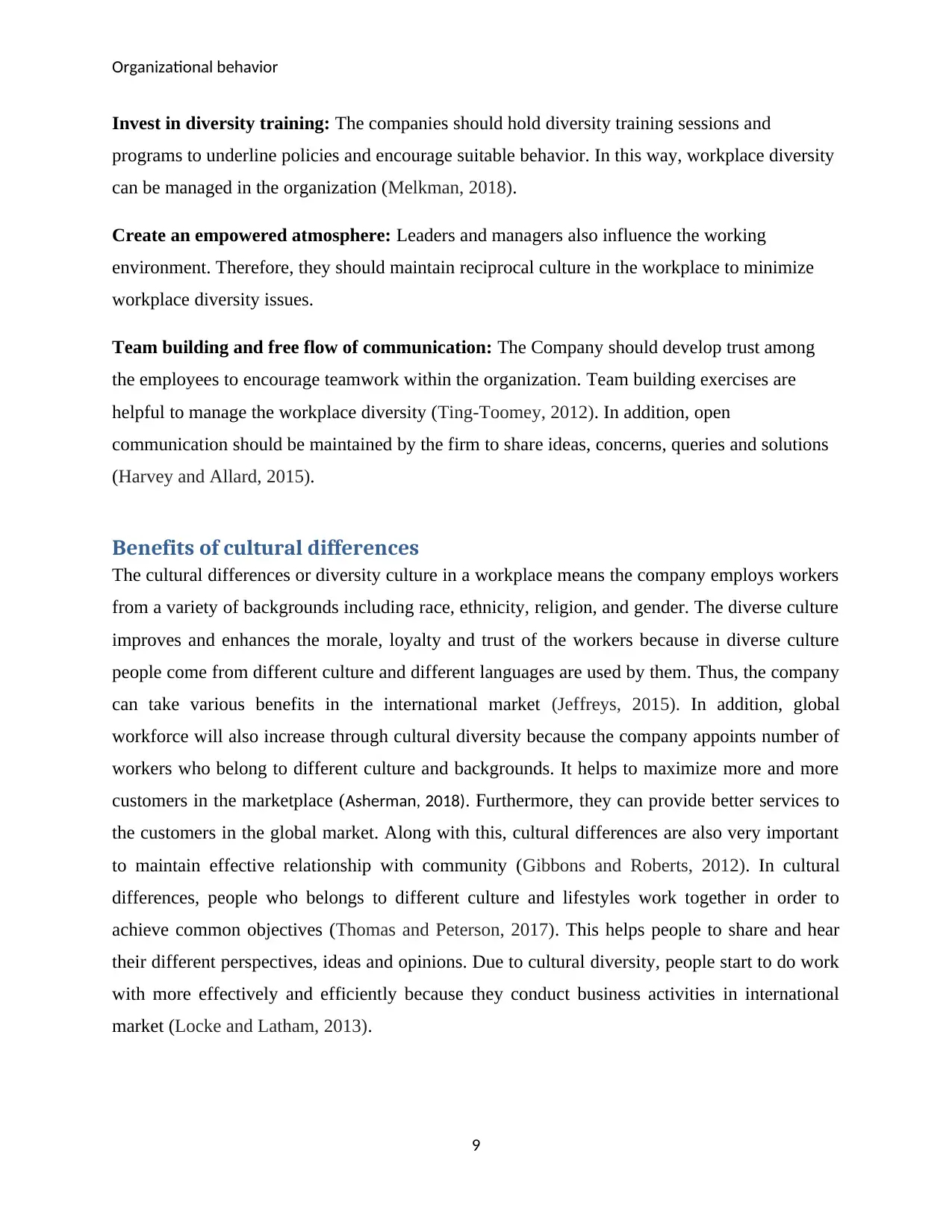
Organizational behavior
Invest in diversity training: The companies should hold diversity training sessions and
programs to underline policies and encourage suitable behavior. In this way, workplace diversity
can be managed in the organization (Melkman, 2018).
Create an empowered atmosphere: Leaders and managers also influence the working
environment. Therefore, they should maintain reciprocal culture in the workplace to minimize
workplace diversity issues.
Team building and free flow of communication: The Company should develop trust among
the employees to encourage teamwork within the organization. Team building exercises are
helpful to manage the workplace diversity (Ting-Toomey, 2012). In addition, open
communication should be maintained by the firm to share ideas, concerns, queries and solutions
(Harvey and Allard, 2015).
Benefits of cultural differences
The cultural differences or diversity culture in a workplace means the company employs workers
from a variety of backgrounds including race, ethnicity, religion, and gender. The diverse culture
improves and enhances the morale, loyalty and trust of the workers because in diverse culture
people come from different culture and different languages are used by them. Thus, the company
can take various benefits in the international market (Jeffreys, 2015). In addition, global
workforce will also increase through cultural diversity because the company appoints number of
workers who belong to different culture and backgrounds. It helps to maximize more and more
customers in the marketplace (Asherman, 2018). Furthermore, they can provide better services to
the customers in the global market. Along with this, cultural differences are also very important
to maintain effective relationship with community (Gibbons and Roberts, 2012). In cultural
differences, people who belongs to different culture and lifestyles work together in order to
achieve common objectives (Thomas and Peterson, 2017). This helps people to share and hear
their different perspectives, ideas and opinions. Due to cultural diversity, people start to do work
with more effectively and efficiently because they conduct business activities in international
market (Locke and Latham, 2013).
9
Invest in diversity training: The companies should hold diversity training sessions and
programs to underline policies and encourage suitable behavior. In this way, workplace diversity
can be managed in the organization (Melkman, 2018).
Create an empowered atmosphere: Leaders and managers also influence the working
environment. Therefore, they should maintain reciprocal culture in the workplace to minimize
workplace diversity issues.
Team building and free flow of communication: The Company should develop trust among
the employees to encourage teamwork within the organization. Team building exercises are
helpful to manage the workplace diversity (Ting-Toomey, 2012). In addition, open
communication should be maintained by the firm to share ideas, concerns, queries and solutions
(Harvey and Allard, 2015).
Benefits of cultural differences
The cultural differences or diversity culture in a workplace means the company employs workers
from a variety of backgrounds including race, ethnicity, religion, and gender. The diverse culture
improves and enhances the morale, loyalty and trust of the workers because in diverse culture
people come from different culture and different languages are used by them. Thus, the company
can take various benefits in the international market (Jeffreys, 2015). In addition, global
workforce will also increase through cultural diversity because the company appoints number of
workers who belong to different culture and backgrounds. It helps to maximize more and more
customers in the marketplace (Asherman, 2018). Furthermore, they can provide better services to
the customers in the global market. Along with this, cultural differences are also very important
to maintain effective relationship with community (Gibbons and Roberts, 2012). In cultural
differences, people who belongs to different culture and lifestyles work together in order to
achieve common objectives (Thomas and Peterson, 2017). This helps people to share and hear
their different perspectives, ideas and opinions. Due to cultural diversity, people start to do work
with more effectively and efficiently because they conduct business activities in international
market (Locke and Latham, 2013).
9
⊘ This is a preview!⊘
Do you want full access?
Subscribe today to unlock all pages.

Trusted by 1+ million students worldwide
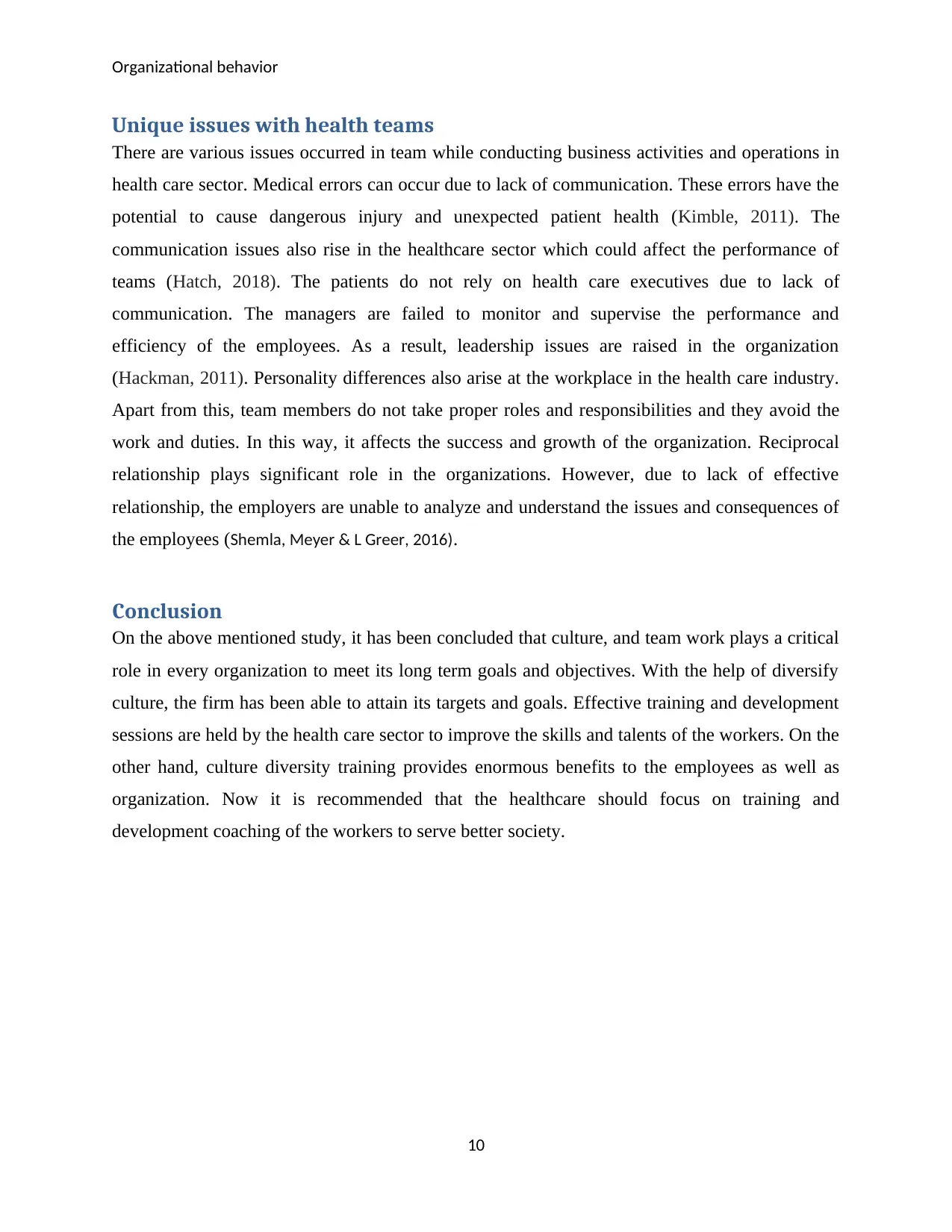
Organizational behavior
Unique issues with health teams
There are various issues occurred in team while conducting business activities and operations in
health care sector. Medical errors can occur due to lack of communication. These errors have the
potential to cause dangerous injury and unexpected patient health (Kimble, 2011). The
communication issues also rise in the healthcare sector which could affect the performance of
teams (Hatch, 2018). The patients do not rely on health care executives due to lack of
communication. The managers are failed to monitor and supervise the performance and
efficiency of the employees. As a result, leadership issues are raised in the organization
(Hackman, 2011). Personality differences also arise at the workplace in the health care industry.
Apart from this, team members do not take proper roles and responsibilities and they avoid the
work and duties. In this way, it affects the success and growth of the organization. Reciprocal
relationship plays significant role in the organizations. However, due to lack of effective
relationship, the employers are unable to analyze and understand the issues and consequences of
the employees (Shemla, Meyer & L Greer, 2016).
Conclusion
On the above mentioned study, it has been concluded that culture, and team work plays a critical
role in every organization to meet its long term goals and objectives. With the help of diversify
culture, the firm has been able to attain its targets and goals. Effective training and development
sessions are held by the health care sector to improve the skills and talents of the workers. On the
other hand, culture diversity training provides enormous benefits to the employees as well as
organization. Now it is recommended that the healthcare should focus on training and
development coaching of the workers to serve better society.
10
Unique issues with health teams
There are various issues occurred in team while conducting business activities and operations in
health care sector. Medical errors can occur due to lack of communication. These errors have the
potential to cause dangerous injury and unexpected patient health (Kimble, 2011). The
communication issues also rise in the healthcare sector which could affect the performance of
teams (Hatch, 2018). The patients do not rely on health care executives due to lack of
communication. The managers are failed to monitor and supervise the performance and
efficiency of the employees. As a result, leadership issues are raised in the organization
(Hackman, 2011). Personality differences also arise at the workplace in the health care industry.
Apart from this, team members do not take proper roles and responsibilities and they avoid the
work and duties. In this way, it affects the success and growth of the organization. Reciprocal
relationship plays significant role in the organizations. However, due to lack of effective
relationship, the employers are unable to analyze and understand the issues and consequences of
the employees (Shemla, Meyer & L Greer, 2016).
Conclusion
On the above mentioned study, it has been concluded that culture, and team work plays a critical
role in every organization to meet its long term goals and objectives. With the help of diversify
culture, the firm has been able to attain its targets and goals. Effective training and development
sessions are held by the health care sector to improve the skills and talents of the workers. On the
other hand, culture diversity training provides enormous benefits to the employees as well as
organization. Now it is recommended that the healthcare should focus on training and
development coaching of the workers to serve better society.
10
Paraphrase This Document
Need a fresh take? Get an instant paraphrase of this document with our AI Paraphraser
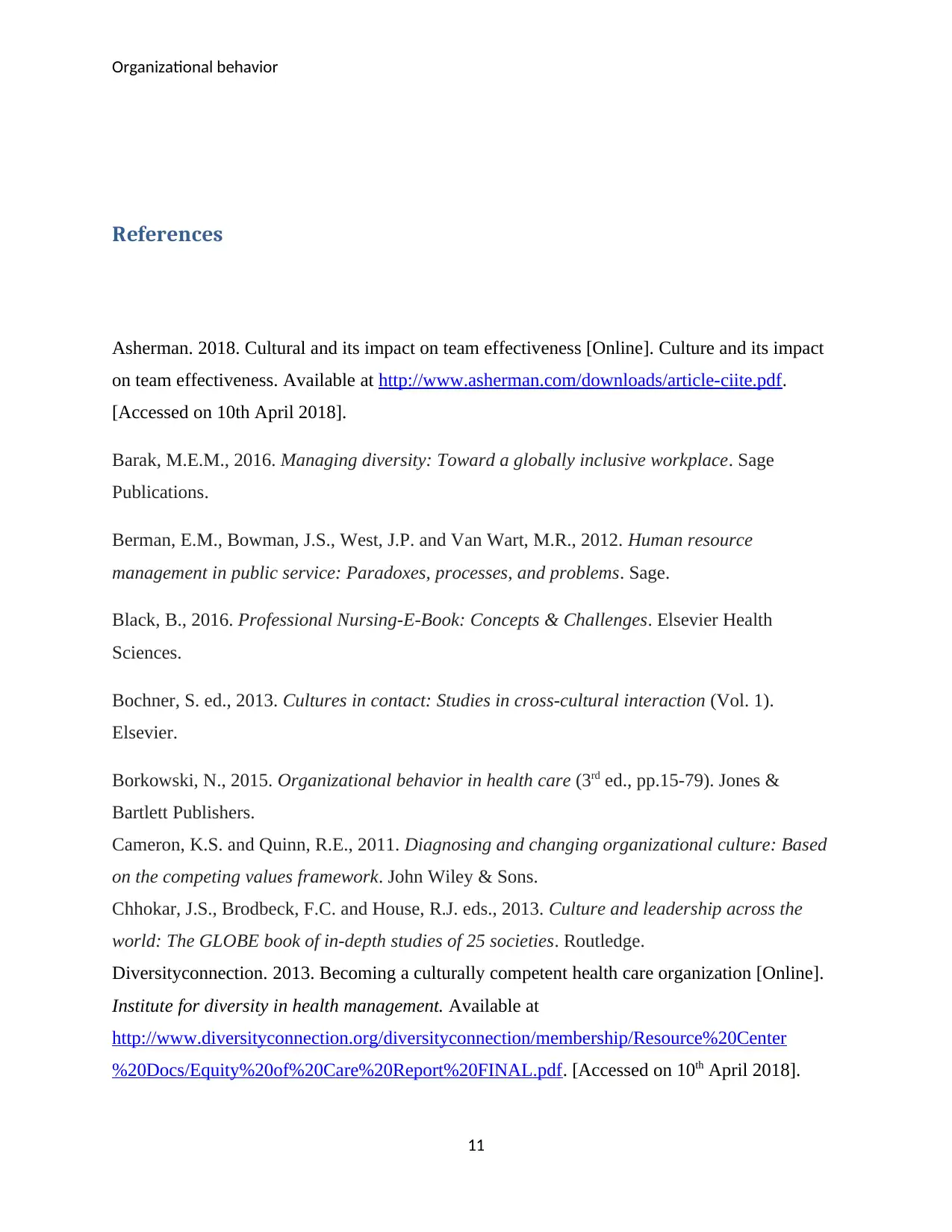
Organizational behavior
References
Asherman. 2018. Cultural and its impact on team effectiveness [Online]. Culture and its impact
on team effectiveness. Available at http://www.asherman.com/downloads/article-ciite.pdf.
[Accessed on 10th April 2018].
Barak, M.E.M., 2016. Managing diversity: Toward a globally inclusive workplace. Sage
Publications.
Berman, E.M., Bowman, J.S., West, J.P. and Van Wart, M.R., 2012. Human resource
management in public service: Paradoxes, processes, and problems. Sage.
Black, B., 2016. Professional Nursing-E-Book: Concepts & Challenges. Elsevier Health
Sciences.
Bochner, S. ed., 2013. Cultures in contact: Studies in cross-cultural interaction (Vol. 1).
Elsevier.
Borkowski, N., 2015. Organizational behavior in health care (3rd ed., pp.15-79). Jones &
Bartlett Publishers.
Cameron, K.S. and Quinn, R.E., 2011. Diagnosing and changing organizational culture: Based
on the competing values framework. John Wiley & Sons.
Chhokar, J.S., Brodbeck, F.C. and House, R.J. eds., 2013. Culture and leadership across the
world: The GLOBE book of in-depth studies of 25 societies. Routledge.
Diversityconnection. 2013. Becoming a culturally competent health care organization [Online].
Institute for diversity in health management. Available at
http://www.diversityconnection.org/diversityconnection/membership/Resource%20Center
%20Docs/Equity%20of%20Care%20Report%20FINAL.pdf. [Accessed on 10th April 2018].
11
References
Asherman. 2018. Cultural and its impact on team effectiveness [Online]. Culture and its impact
on team effectiveness. Available at http://www.asherman.com/downloads/article-ciite.pdf.
[Accessed on 10th April 2018].
Barak, M.E.M., 2016. Managing diversity: Toward a globally inclusive workplace. Sage
Publications.
Berman, E.M., Bowman, J.S., West, J.P. and Van Wart, M.R., 2012. Human resource
management in public service: Paradoxes, processes, and problems. Sage.
Black, B., 2016. Professional Nursing-E-Book: Concepts & Challenges. Elsevier Health
Sciences.
Bochner, S. ed., 2013. Cultures in contact: Studies in cross-cultural interaction (Vol. 1).
Elsevier.
Borkowski, N., 2015. Organizational behavior in health care (3rd ed., pp.15-79). Jones &
Bartlett Publishers.
Cameron, K.S. and Quinn, R.E., 2011. Diagnosing and changing organizational culture: Based
on the competing values framework. John Wiley & Sons.
Chhokar, J.S., Brodbeck, F.C. and House, R.J. eds., 2013. Culture and leadership across the
world: The GLOBE book of in-depth studies of 25 societies. Routledge.
Diversityconnection. 2013. Becoming a culturally competent health care organization [Online].
Institute for diversity in health management. Available at
http://www.diversityconnection.org/diversityconnection/membership/Resource%20Center
%20Docs/Equity%20of%20Care%20Report%20FINAL.pdf. [Accessed on 10th April 2018].
11
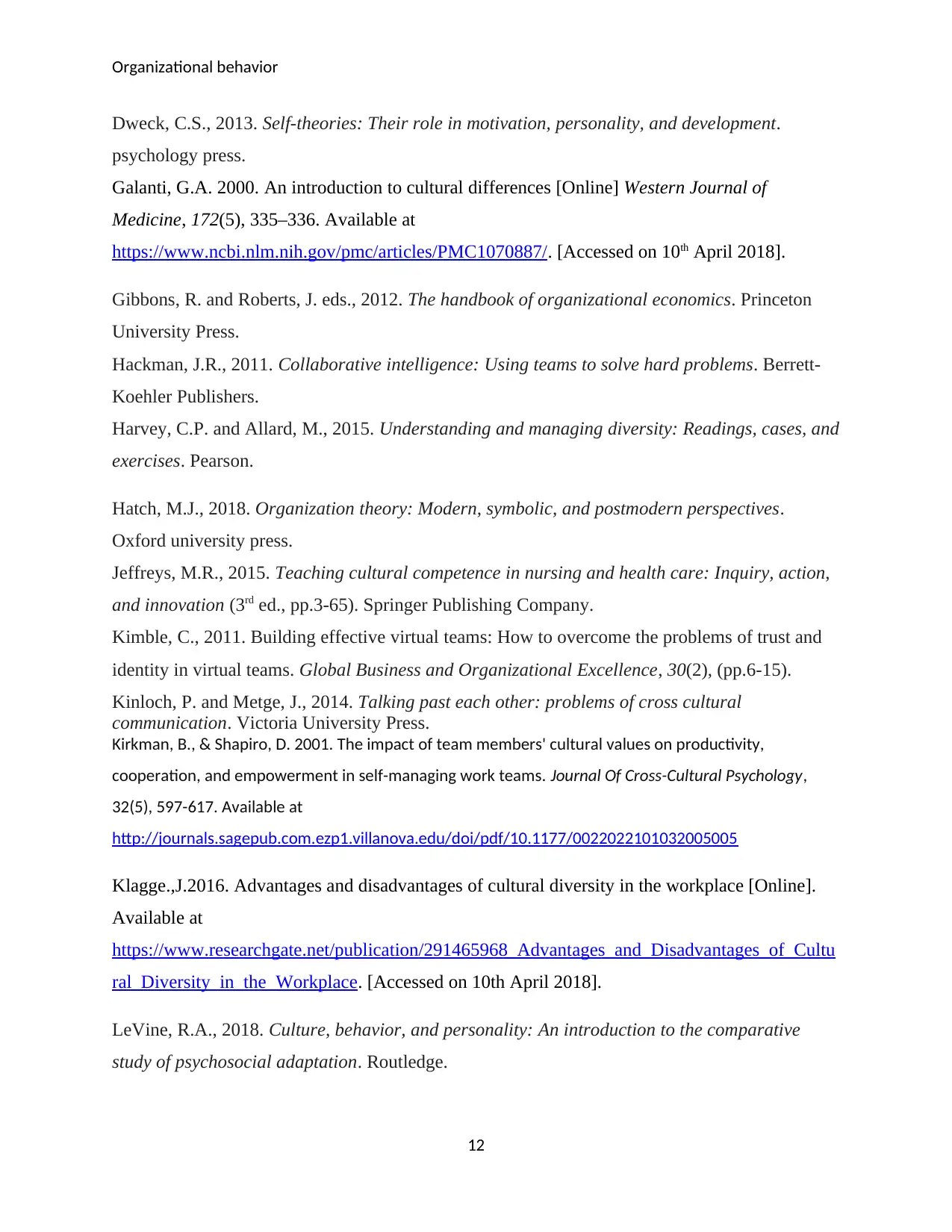
Organizational behavior
Dweck, C.S., 2013. Self-theories: Their role in motivation, personality, and development.
psychology press.
Galanti, G.A. 2000. An introduction to cultural differences [Online] Western Journal of
Medicine, 172(5), 335–336. Available at
https://www.ncbi.nlm.nih.gov/pmc/articles/PMC1070887/. [Accessed on 10th April 2018].
Gibbons, R. and Roberts, J. eds., 2012. The handbook of organizational economics. Princeton
University Press.
Hackman, J.R., 2011. Collaborative intelligence: Using teams to solve hard problems. Berrett-
Koehler Publishers.
Harvey, C.P. and Allard, M., 2015. Understanding and managing diversity: Readings, cases, and
exercises. Pearson.
Hatch, M.J., 2018. Organization theory: Modern, symbolic, and postmodern perspectives.
Oxford university press.
Jeffreys, M.R., 2015. Teaching cultural competence in nursing and health care: Inquiry, action,
and innovation (3rd ed., pp.3-65). Springer Publishing Company.
Kimble, C., 2011. Building effective virtual teams: How to overcome the problems of trust and
identity in virtual teams. Global Business and Organizational Excellence, 30(2), (pp.6-15).
Kinloch, P. and Metge, J., 2014. Talking past each other: problems of cross cultural
communication. Victoria University Press.
Kirkman, B., & Shapiro, D. 2001. The impact of team members' cultural values on productivity,
cooperation, and empowerment in self-managing work teams. Journal Of Cross-Cultural Psychology,
32(5), 597-617. Available at
http://journals.sagepub.com.ezp1.villanova.edu/doi/pdf/10.1177/0022022101032005005
Klagge.,J.2016. Advantages and disadvantages of cultural diversity in the workplace [Online].
Available at
https://www.researchgate.net/publication/291465968_Advantages_and_Disadvantages_of_Cultu
ral_Diversity_in_the_Workplace. [Accessed on 10th April 2018].
LeVine, R.A., 2018. Culture, behavior, and personality: An introduction to the comparative
study of psychosocial adaptation. Routledge.
12
Dweck, C.S., 2013. Self-theories: Their role in motivation, personality, and development.
psychology press.
Galanti, G.A. 2000. An introduction to cultural differences [Online] Western Journal of
Medicine, 172(5), 335–336. Available at
https://www.ncbi.nlm.nih.gov/pmc/articles/PMC1070887/. [Accessed on 10th April 2018].
Gibbons, R. and Roberts, J. eds., 2012. The handbook of organizational economics. Princeton
University Press.
Hackman, J.R., 2011. Collaborative intelligence: Using teams to solve hard problems. Berrett-
Koehler Publishers.
Harvey, C.P. and Allard, M., 2015. Understanding and managing diversity: Readings, cases, and
exercises. Pearson.
Hatch, M.J., 2018. Organization theory: Modern, symbolic, and postmodern perspectives.
Oxford university press.
Jeffreys, M.R., 2015. Teaching cultural competence in nursing and health care: Inquiry, action,
and innovation (3rd ed., pp.3-65). Springer Publishing Company.
Kimble, C., 2011. Building effective virtual teams: How to overcome the problems of trust and
identity in virtual teams. Global Business and Organizational Excellence, 30(2), (pp.6-15).
Kinloch, P. and Metge, J., 2014. Talking past each other: problems of cross cultural
communication. Victoria University Press.
Kirkman, B., & Shapiro, D. 2001. The impact of team members' cultural values on productivity,
cooperation, and empowerment in self-managing work teams. Journal Of Cross-Cultural Psychology,
32(5), 597-617. Available at
http://journals.sagepub.com.ezp1.villanova.edu/doi/pdf/10.1177/0022022101032005005
Klagge.,J.2016. Advantages and disadvantages of cultural diversity in the workplace [Online].
Available at
https://www.researchgate.net/publication/291465968_Advantages_and_Disadvantages_of_Cultu
ral_Diversity_in_the_Workplace. [Accessed on 10th April 2018].
LeVine, R.A., 2018. Culture, behavior, and personality: An introduction to the comparative
study of psychosocial adaptation. Routledge.
12
⊘ This is a preview!⊘
Do you want full access?
Subscribe today to unlock all pages.

Trusted by 1+ million students worldwide
1 out of 14
Related Documents
Your All-in-One AI-Powered Toolkit for Academic Success.
+13062052269
info@desklib.com
Available 24*7 on WhatsApp / Email
![[object Object]](/_next/static/media/star-bottom.7253800d.svg)
Unlock your academic potential
Copyright © 2020–2025 A2Z Services. All Rights Reserved. Developed and managed by ZUCOL.



